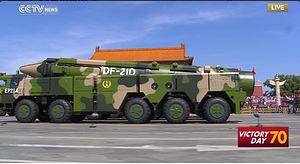The People’s Liberation Army Rocket Force (PLARF) has conducted a number of weapons tests, which included the launch of a new missile type in the northeastern Bohai Sea close to the Korean Peninsula, the Information Bureau of China’s Ministry of National Defense announced on May 9.
In a short statement, the defense ministry noted that the tests occurred in “recent days” and were held in accordance with the PLARF’s annual training schedule. The operational tests of the new missile were purportedly successful and “achieved the expected results.”
The defense ministry first announced the tests two weeks ago during a monthly press conference.
The defense ministry neither revealed the exact missile type tested nor the missile’s launch site. It also did not specify how many missiles were launched. Speculations about the missiles test fired range from a new variant of the intermediate-range DF-26 ballistic missile, the DF-26B, to a new submarine-launched ballistic missile dubbed the JL-3.
The DF-26 hypothesis is primarily fueled by a video first posted on the Internet on April 23 showing what appears to be the wreckage of a new variant of the DF-26 ballistic missile somewhere in Siziwang county in Inner Mongolia, an autonomous region located in northern China. In the video, the inscription E/ADF-26B is clearly visible on the debris of the first or second stage of the missile. It is unclear what the designation stands for. Some analysts believe that the new missile is an extended range anti-ship variant of the DF-26.
As an analysis by East Pendulum, however, notes it appears unlikely that the wreckage found in Inner Mongolia is of a DF-26 missile fired into the Bohai Sea since the missile’s presumed trajectory from west to east is highly unusual (the majority of missile monitoring facilities are located in the country’s West) and would entail passing over heavily populated territory. In addition, the analysis points out various difficulties triangulating known Chinese ballistic missile launch sites (e.g., Korla in Xinjiang province), the location of the wreckage, and the presumed target area in the Bohai Sea.
In addition, the Chinese defense ministry’s press statement also specifically notes that the missile was launched in the Bohai Sea.
Alternatively, the PLARF could have test fired the JL-3 (aka JL-2A), a new submarine-launched ballistic missile (SLBM) developed for the People’s Liberation Army Navy’s latest variant of Type 094 Jin-class nuclear-powered ballistic missile submarines, dubbed Type 094A. The Type 094A submarine, first spotted in 2016, purportedly carries a bigger missile payload and is quieter than the original Type 094 variant. The JL-3 is thought to have a range of up to 12,000 kilometers and was introduced into service in 2016. In a separate analysis, East Pendulum offers a sound hypothesis for a SLBM ejection test in the Bohai Sea (primarily based on a peculiar navigation alert issued by the Maritime Safety Administration of Liaoning province).
A third alternative is that the PLARF test-fired a DF-21D medium range ballistic missile from launch sites in Jingyu or Tonghua in Jilin province, approximately 80 kilometers north of the North Korean border. The DF-21 is the first road-mobile, solid propellant missile developed by China. The DF-21D, dubbed a ‘carrier killer’, is an anti-ship variant of the missile with an estimated range of 1,500-1,700 kilometers. The DF-21D was allegedly first test fired in November 2015. Armed with the DF-ZF (previously known as WU-14) hypersonic glide vehicle (HGV), a high-speed maneuvering warhead currently under development, the DF-21D purportedly can penetrate any U.S. air defense systems based on interceptor missiles.

































